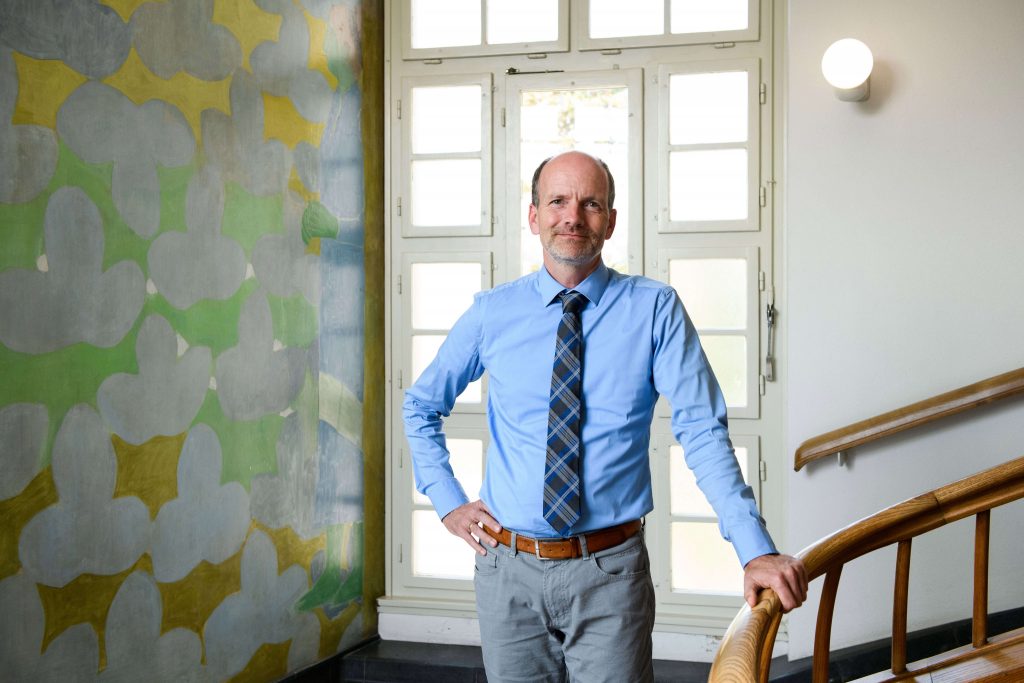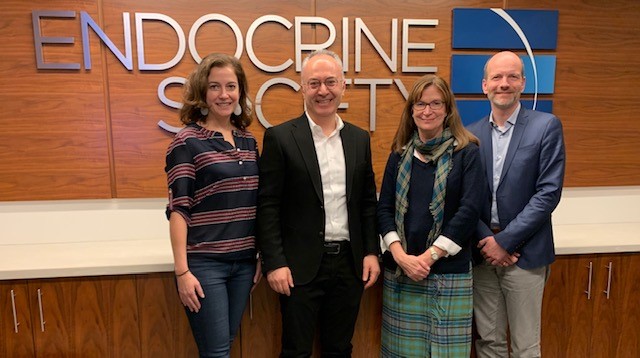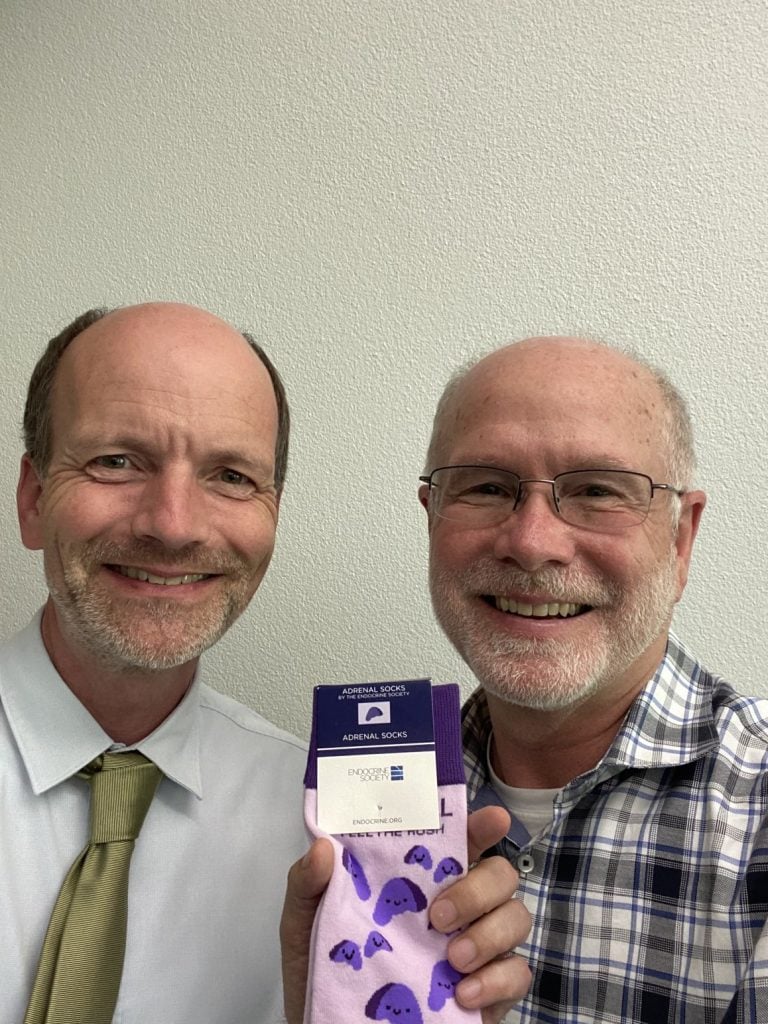
Honored by both the Endocrine Society and the European Society of Endocrinology with the 2024 Transatlantic Alliance Award, Felix Beuschlein, MD, has made significant contributions to endocrine research on both sides of the Atlantic, from Michigan to Switzerland! Endocrine News speaks with Beuschlein about what this award means to him, conducting pioneering research on two different continents, and why he became an endocrinologist in the first place.
In October, the Endocrine Society and the European Society of Endocrinology (ESE) jointly awarded the 2024 Transatlantic Alliance Award to Prof. Felix Beuschlein, MD.
The Transatlantic Alliance Award, which began in 2021, recognizes a leader who has made significant advancements in endocrine research in Europe and the U.S. Beuschlein exemplifies transatlantic endocrine leadership: he joined the University of Michigan in Ann Arbor for his postdoctoral studies in the early 2000s. On returning to Europe, he took a professorship for Endocrine Research at the University of Munich. He is currently professor of internal medicine/endocrinology and director of the Clinic for Endocrinology, Diabetology and Clinical Nutrition at the University Clinic Zurich in Switzerland.
Beuschlein has made outstanding and ongoing contributions to the endocrine community’s fundamental and clinical understanding of adrenal tumors through his collaborative approach.
Among the honors bestowed upon him are the European Journal of Endocrinology Prize and the Society for Endocrinology (UK) European Medal. His accolades extend to the organization of numerous scientific meetings, co-chairing the program organizing committee for a European Congress of Endocrinology (ECE), and heading the annual meeting steering committee for ENDO 2021. Demonstrating a profound commitment to fostering scientific and clinical connections, Beuschlein has actively participated in various national and international initiatives. Noteworthy contributions include coordinating the ENS@T (European Network for the Study of Adrenal Tumors)-CANCER Consortium and engaging in multiple European and international programs.
His involvement spans leadership roles on several boards, encompassing the Annual Meeting Steering Committee of the Endocrine Society, the Executive Committee of the Swiss Endocrine Society, and a term as the vice president of the German Endocrine Society. Additionally, he played a pivotal role as a founding member, Steering Committee participant, and chairman of ENS@T.
Endocrine News asked Beuschlein more about what inspired his career journey and what, if any, challenges arise from conducting endocrine research on both sides of the pond.
Endocrine News: You are only the fourth recipient of the Transatlantic Alliance Award — that must be quite an honor. What does it mean to you?
Felix Beuschlein: It’s a great honor, and it even feels like two awards in one because it’s support from two societies across the Atlantic, from both the European and the American Endocrine societies.
I’m very grateful that I am among the earlier recipients, and I hope this goes on for at least the next century. It’s really fun!
EN: What did the news of your recognition for the 2024 Transatlantic Alliance Award mean to you?
Beuschlein: Receiving the Transatlantic Alliance Award was a deeply humbling and gratifying moment for me. It represented not just a personal achievement, but a recognition of the collaborative efforts and advancements we have made in endocrine research across continents. This award symbolizes the importance of international collaboration in scientific research, something I have always passionately advocated for. It serves as a reminder that our collective efforts, bridging diverse perspectives and expertise, are crucial in advancing our understanding and treatment of endocrine disorders.
EN: Can you talk about the European Network for the Study of Adrenal Tumors (ENS@T)?
Beuschlein: We are now the second generation of ENS@T; in fact, we recently had a meeting where all the founding fathers returned. I was too junior to be involved from the very beginning, but I’ve had the honor of heading it for almost a decade. That network is somewhat of a role model in a way — the A5 consortium (American Australasian Asian Adrenal Alliance) was built with the blueprint of ENS@T, so it has an international legacy. But I think the core of it, and something we just reflected about with the founders, is really about trust and collaboration. It also has many personal connections; it helped me build my own network. Many interesting proposals, studies, and projects have come out of ENS@T over the last almost 20 years. It’s a very productive scientific network.
“There is a good proportion of endocrinology that you have to understand but then you can use it. It’s a very rational yet very deep field. I mean, hormones are quite logical, but they are exciting, and they shape a person down to the bone, literally. So, it’s this combination of very rational aspects — like feedback inhibition and feedforward activation of axes — and physiology, with this other part that is very complex and affects everything in a person.”
EN: How did adrenal tumors become a major area of interest for you?
Beuschlein: Part of it was luck. I met the late Bruno Allolio during my medical school training in Würzburg, Germany, where he had just started his endocrine department. I happened to run into him during a lecture and asked him if there would be a chance to join his group, and he said yes. That was the start, and I never left the field. It could have been something very different, but this was destiny. He really was a very inspiring person.
EN: Are there other mentors you would care to talk about?
Beuschlein: The second person is Martin Reincke. He was also in that Würzburg group, but transferred to another place in Germany and asked me whether I would join. I did so and followed him for quite some time. Now comes the American part. The third person I would mention is Gary Hammer, MD, PhD, past president of the Endocrine Society and a great mentor and friend. When he joined the University of Michigan in Ann Arbor, I was among the first postdocs in his lab. That was due to another friend and colleague — Wiebke Arlt, MD, DSc, FRCP, FMedSci — also a leader in the adrenal field who was in a lab that neighbored Gary’s then lab in San Francisco. She told me about this ‘interesting guy’ heading to Ann Arbor and suggested I visit him. I thought that sounded crazy until I realized that Chicago is not that far away from Ann Arbor, and so I got in the car and drove there. I interviewed with him and was quite impressed. It’s one of those things in life where you say, ‘well why not?’, and my wife and our then two small children moved there for two years. It was a very active and intensive period, but in hindsight it was good to have this kind of period to concentrate on what you do and then move on. In this case, moving on did not mean that I cut those ties. I’m still in very close contact and collaborate with people from Ann Arbor and many others. So that certainly was an important part of my career, and it was another branch of the network that I’m still feeding on.

EN: You also pay it forward by dedicating yourself to teaching and mentoring young researchers at the University Clinic Zurich and in your many international collaborations. What words of advice do you often share about how you have made your journey from where they are now to your current success?
Beuschlein: To young researchers embarking on their careers, my advice is to first and foremost find a question that truly excites you, one that holds clinical or scientific significance. This passion will be the driving force behind your work. Early in your career, make an effort to build a robust network. Changing locations and positions might be daunting, but, as I’ve experienced, it greatly enhances your exposure and opens new opportunities. Trust in the power of collaboration. These partnerships, often spanning different disciplines and cultures, can lead to groundbreaking discoveries.
Lastly, maintain your curiosity. The field of endocrinology is continuously evolving, and staying curious is key to adapting and contributing to its growth.
EN: What are you currently working on?
Beuschlein: I got this position in Zurich six years ago, and Switzerland is an amazing and beautiful place, but it is a small country. I realized that I wasn’t going to be able to get into large numbers with the diseases I had been involved in like adrenocortical cancer, because there are only so many in the whole Swiss population. So, I had to actively shift my focus to more prevalent disorders, and I chose hypertension and obesity. I tried to ‘adrenalize’ my work in the regard that with hypertension, primary aldosteronism, obesity, there are aspects of glucocorticoid action. Now we have large projects running where we look into the glucocorticoid burden of patients with obesity as the basis of new diagnostic approaches but also as a possibility for personalized treatment approaches. And the same with hypertension — we do try to improve the identification and the treatment of patients with primary aldosteronism. I just recently looked in the data again, and internationally it really remains a very underappreciated disease. Hypertension is so very common, and 5% to 8% of hypertension patients have primary aldosteronism. However, only a very small minority is diagnosed, even if you look into more specific subgroups, like those with hypokalemia. We just did a study where we found that in the range of 50% of patients who once had quite low potassium levels had, in the end, primary aldosteronism. I know from international data that only 2% of this patient group is ever screened — 98% would be good! We’re so far away from a decent screening approach that we have to figure out how to improve this, and I think the key will be to make it as simple as possible and maybe even have some automation in the diagnostic procedure. That’s an example that we are trying to implement, and this would be something that would change clinical practice. Part of that is teaching and informing students, GPs, cardiologists, and everybody else, but another part is the strategies and epidemiological thoughts about how that can be improved.
“To young researchers embarking on their careers, my advice is to first and foremost find a question that truly excites you, one that holds clinical or scientific significance. This passion will be the driving force behind your work.”
EN: So, is there a clinical guideline in your future?
Beuschlein: I’m just finishing the last touches of the first combined guideline from the Endocrine Society and the European Society of Endocrinology on glucocorticoid-induced adrenal insufficiency. It’s a great group across the globe but primarily from Europe and the U.S. That will go out for review shortly, and it will also be presented both in Stockholm at the European meeting and in Boston at ENDO 2024. I will have two stages to fill in Boston — one with the guideline and the other with the Transatlantic Alliance Award, which again is a tremendous honor. I do remember my first Endocrine Society meeting a long time ago where I was very honored to give a talk. In my recollection, it was a huge audience, and I was super excited but even more frightened. Giving this talk in front of all these people who probably knew more than I do — that was ‘adrenal training’ for sure!
EN: What drew you to endocrinology in general?
Beuschlein: Well, as I was saying, it was a little bit of good luck, but of course I would have left the field if I had not been turned on by it. I tell this to my students all the time: there is a good proportion of endocrinology that you have to understand but then you can use it. It’s a very rational yet very deep field. I mean, hormones are quite logical, but they are exciting, and they shape a person down to the bone, literally. So, it’s this combination of very rational aspects — like feedback inhibition and feedforward activation of axes — and physiology, with this other part that is very complex and affects everything in a person. A tumor can produce hormones that make a patient sick and change their personality. To this day, I think that’s just fascinating. That’s part of it, the clinical procedure, but I was also drawn into science and asking questions. I could have done this in other fields, but I like this combination of logic and complex. I’m very grateful that that I was given this opportunity. I have another dozen years or so before my retirement, and I don’t see that this passion is going to change so I’ll just stay with it. We’re merely scratching the surface.

Another field that I’m actively working on is sensors. If you measure glucose, you can see all these subtle small differences, which has revolutionized diabetology. Why not do the same with other hormones and steroids? With this kind of continuous measurement, you are able to find rhythms — sick and not sick, stressed and not stressed, and so on. Continuous measurement is quite interesting, but another way is to measure deep. At one point, measure every single hormone that you can think of and those patterns that come out of it, which we as humans cannot even grasp any longer and need AI (artificial intelligence).
EN: Do you use AI as an endocrinologist?
Beuschlein: I helped train an AI for making diagnostics for pheochromocytoma and paraganglioma. There was a training set of a few hundred patients, and, as the expert, I was given information to make a diagnosis. I realized, yes, you can do this, but you’re only really concentrating for the first five. After 10, you start feeling tired, and it’s really tough to do this over and over again. But for a machine, this is not a problem at all. In the end, we were all worse than the AI in making a diagnosis. So, it’s quite clear to me that the diagnostic approaches will change, and part of that is we are not good at repetition. We cannot grasp more than say two or three numbers or hormones or so at the same time. Still, in the end, someone needs to be responsible and to say, ‘yes I think that’s the ground truth’, or it’s not and to break the news to patients as well. But there has also been a study that AI is better to deliver news to a patient in comparison to real doctors, at least in written responses. The future is going to stay interesting.
“Regardless of the geographical location, the underlying questions that drive our research, and the passion for finding answers are universal. We share a common breed of researchers and scientists, and we are peers across borders.”
EN: What would say are the biggest similarities and differences in laboratory research work in the United States versus Switzerland? Do any major challenges occur when you collaborate with peers here in America?
Beuschlein: The realms of clinical and laboratory research in the U.S. and Switzerland are more alike than they are different. Regardless of the geographical location, the underlying questions that drive our research, and the passion for finding answers are universal. We share a common breed of researchers and scientists, and we are peers across borders. One notable difference in Europe is the tendency for smaller units or departments that requires multi-centric collaboration, which naturally fosters a culture of cooperation. Over time, this approach has proven to be quite successful. Furthermore, there are more funding schemes in Europe that encourage such collaborative efforts.
The major challenges in international collaborations often relate to regulations on data protection and material transfer agreements. While these regulations are essential for ethical research, they can be quite challenging for someone with an impatient disposition like me.
Horvath is a freelance writer based in Baltimore, Md. In the January issue, she wrote about a variety of thyroid cancer studies. Fauntleroy-Shaw is a freelance writer based in Carmel, Ind., and oversees the “Laboratory Notes” column.

